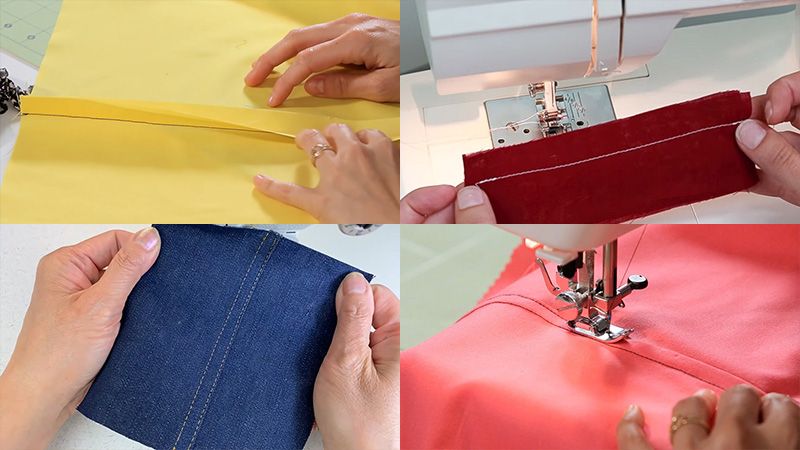
Seams are an important part of any garment, allowing pieces of fabric to be joined together and creating the desired shape. There are a variety of different seam types which can be used depending on the fabric type, design and function of the garment.
Some of the most common types of seams are flat seams, French seams, felled seams, overlocked seams and bound seams. Each of these seams has its own benefits and drawbacks, making them suitable for different applications.
This guide will provide an overview of the different types of seams and their uses.
1. French Seam
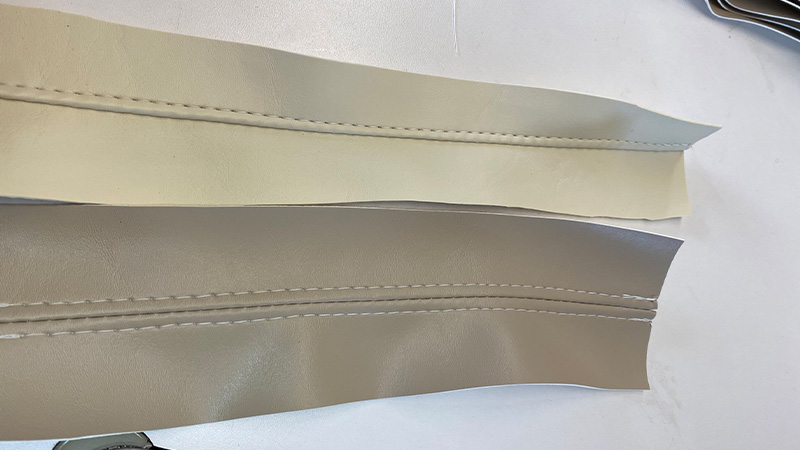
A French seam is a meticulously crafted sewing technique known for its elegance and functionality. Unlike conventional seams, it encases raw fabric edges, creating a clean, polished finish on both the inside and outside of a garment.
To create a French seam, fabric pieces are initially sewn with their wrong sides together, followed by trimming the seam allowance and folding the fabric, encasing the raw edges.
A second seam is then stitched, sealing the edges within, resulting in a neat, durable, and aesthetically pleasing seam. This method is often used for delicate or sheer fabrics and is a testament to the artistry of sewing craftsmanship.
2. Lapped Seam
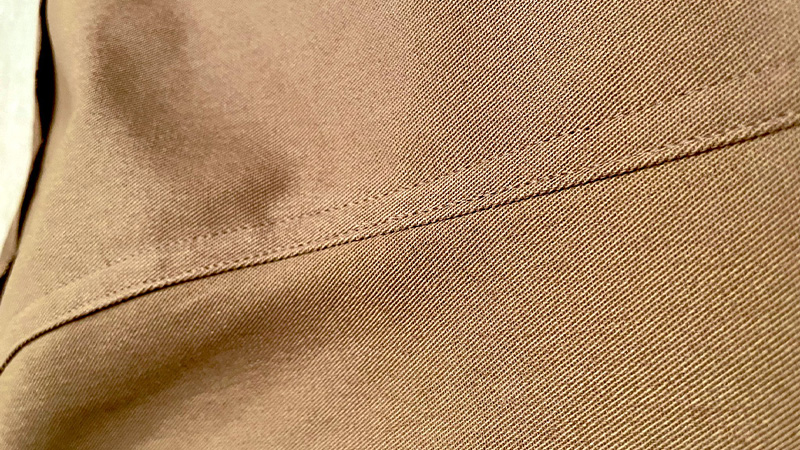
A lapped seam is a sewing technique employed to create a low-profile, neat finish in garments. It involves folding one fabric edge over the other and stitching them together, concealing raw edges.
Lapped seams are commonly found in tailored clothing, reducing bulk and offering a clean appearance. They are particularly useful when working with heavy or bulky fabrics and are often seen in trouser sides, where durability and a streamlined look are essential.
This method showcases the precision of skilled seamstresses, ensuring garments not only look refined but also maintain their structural integrity over time.
3. Plain Seam
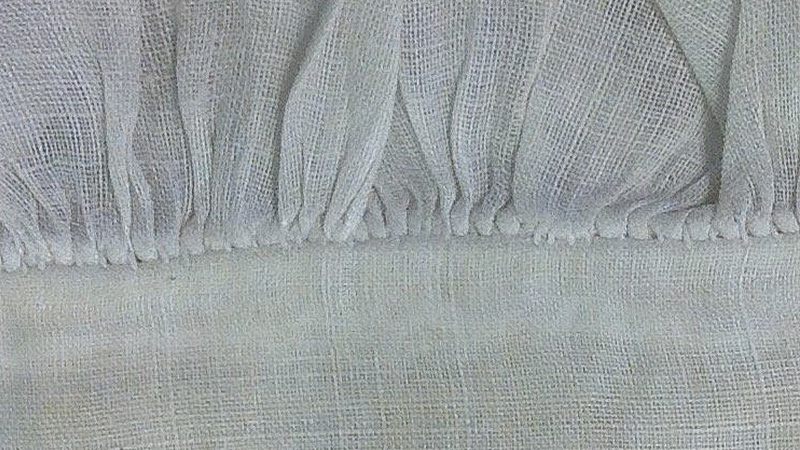
A plain seam, also known as a single-stitched seam, is the fundamental building block of sewing. In this uncomplicated yet essential technique, two fabric pieces with their right sides together are stitched along the edge, joining them securely.
It forms the basis for most sewing projects and is suitable for a wide range of fabric types, from delicate silks to sturdy denims. While seemingly simple, mastering the art of creating even, straight plain seams is crucial for achieving professional results in sewing.
This foundational skill lays the groundwork for more advanced seam techniques and opens the door to endless creative possibilities in the world of textiles and fashion.
4. Bound Seam
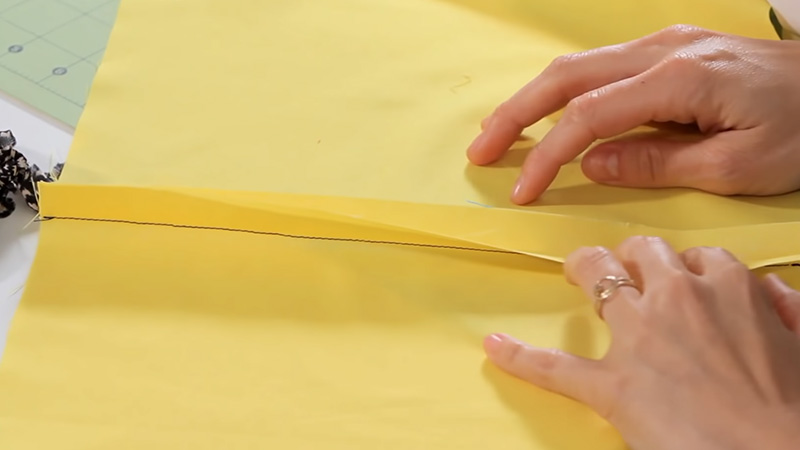
A bound seam is a sewing technique that adds strength, durability, and a decorative touch to the edges of fabric. It involves encasing the raw edges of a seam with a strip of fabric, often bias tape, which is stitched in place.
This not only conceals the frayed edges but also reinforces the seam. Bound seams are commonly used in areas that may undergo stress, such as armholes, neckline edges, or the crotch seam in pants.
Beyond their functional benefits, bound seams offer a creative element, allowing seamstresses to introduce contrasting colors or patterns to their projects, enhancing both form and function.
5. Welt Seam
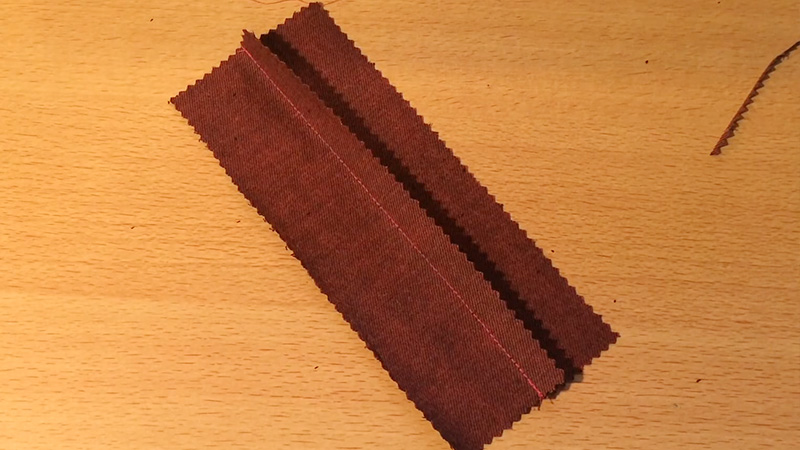
A welt seam is a sophisticated sewing technique known for its clean, streamlined appearance. It’s often used in high-quality tailoring and upholstery work.
In this method, two fabric pieces are joined with a narrow strip of fabric, known as a welt, sandwiched between them. This creates a raised, decorative seam that is not only visually appealing but also reinforces the joint, making it sturdy and durable.
Welt seams are frequently seen on blazer pockets, leather goods, and in the construction of upholstered furniture. This advanced technique requires precision and attention to detail, resulting in a polished, professional finish in sewing projects.
6. Flat Felled Seam
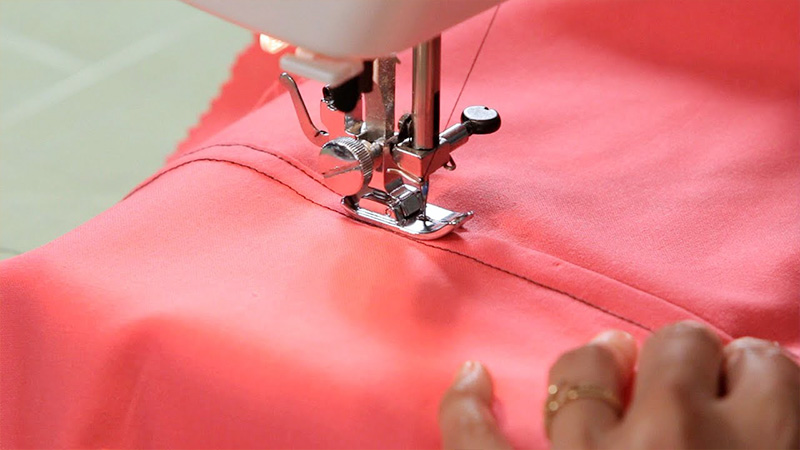
A flat-felled seam is a robust and aesthetically pleasing sewing technique renowned for its use in durable and long-lasting garments like jeans and workwear.
In a flat-felled seam, two fabric edges are stitched together with the raw edges enclosed and one side folded over the other. This creates a strong, flat seam with no raw edges exposed.
Flat-felled seams are known for their durability, as they can withstand heavy wear and laundering. They also provide a clean, finished look on both the outside and inside of a garment.
This method is a hallmark of quality construction and is often seen in rugged, utilitarian clothing.
7. Open Seam
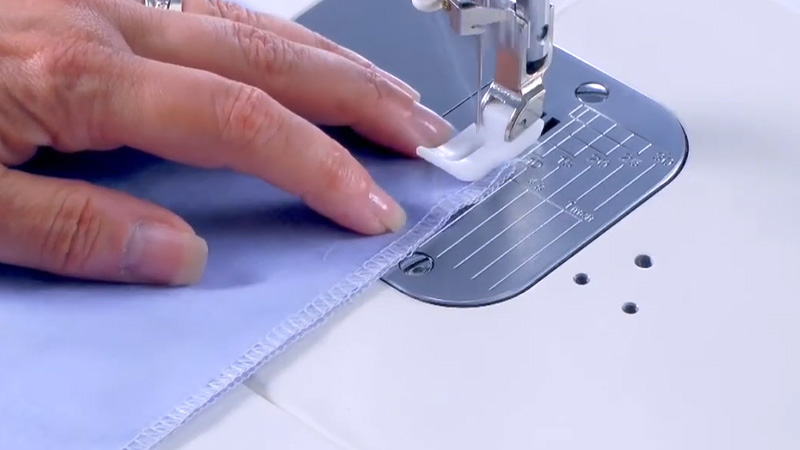
An open seam, also known as an unfinished seam or raw seam, is a type of seam where the raw edges of fabric are left exposed without any finishing treatment.
This technique is intentionally used for specific design purposes, especially in fashion and textile art, to create a raw, unfinished, or deconstructed look.
Open seams can add texture, character, and a sense of uniqueness to garments or textile projects. They often require careful handling to prevent fraying, and the choice of fabric and sewing method is essential in achieving the desired aesthetic.
While not suitable for all applications, open seams can offer a creative and edgy touch to fashion and textile design.
8. Serged Seam
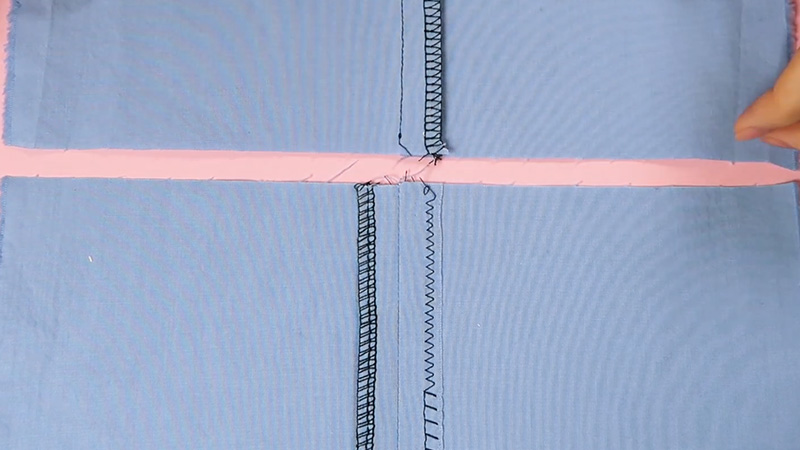
A serged seam, created using a serger or overlock machine, is a popular choice in sewing for its durability and ability to prevent fraying. This type of seam trims the fabric edges and simultaneously encases them in a neat row of interlocking stitches.
Serged seams are commonly used in knit fabrics, where their stretch-friendly properties are advantageous. They also feature in finishing raw edges on various textiles, such as garments, linens, and home decor items.
Though primarily functional, the characteristic row of overlock stitches in a serged seam can also serve as a decorative element, making it a versatile and essential technique in sewing and garment construction.
9. Hairline Seam
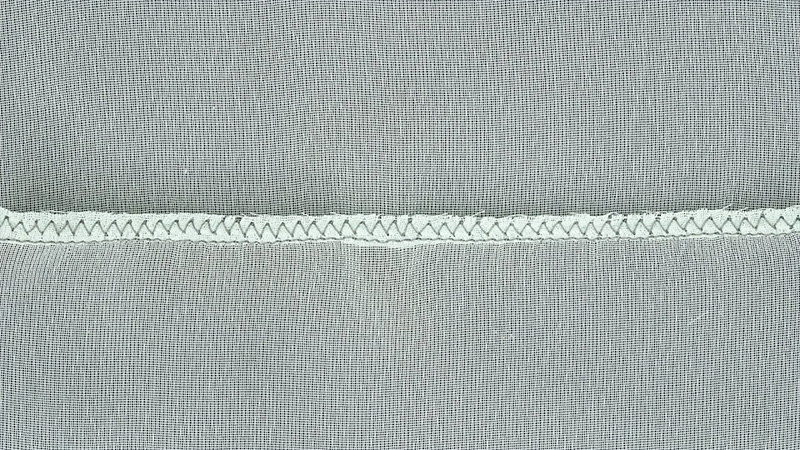
A hairline seam, also referred to as an edge or razor-thin seam, is an exceptionally fine and delicate sewing technique. It involves stitching fabric pieces together with the utmost precision, creating a seam so narrow that it is nearly invisible to the naked eye.
Hairline seams are typically used in high-end fashion and couture, as they demand exceptional skill and attention to detail. The goal is to maintain the fabric’s integrity while achieving an impeccably clean and unobtrusive finish.
This technique is often reserved for sheer, lightweight fabrics and special occasions, where subtlety and an exquisite touch are paramount.
10. Double Stitched Seam
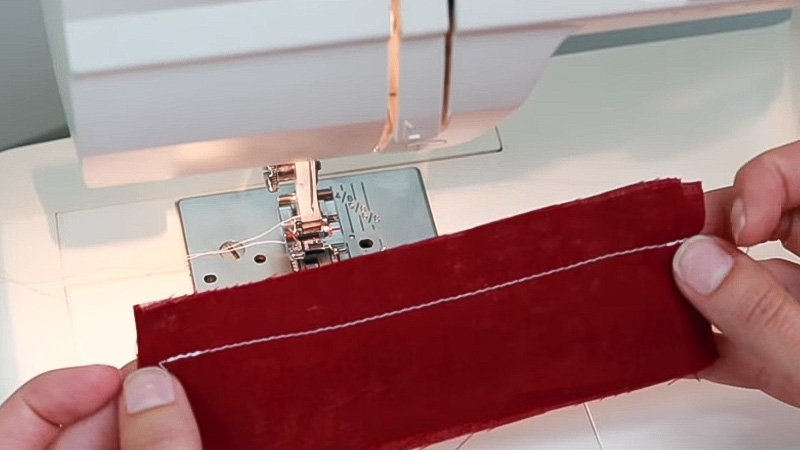
A double-stitched seam is a reinforced sewing technique used to enhance the strength and durability of a seam. In this method, two parallel lines of stitching are sewn side by side, typically about 1/8 to 1/4 inch apart, along the seam allowance.
This extra row of stitches provides added security, reducing the risk of the seam unraveling or stretching. Double-stitched seams are commonly used in heavy-duty applications, such as denim jeans, upholstery, and outdoor gear, where the fabric undergoes significant stress.
This technique not only reinforces the seam but also adds a decorative touch, making it both functional and visually appealing.
11. Superimposed Seam
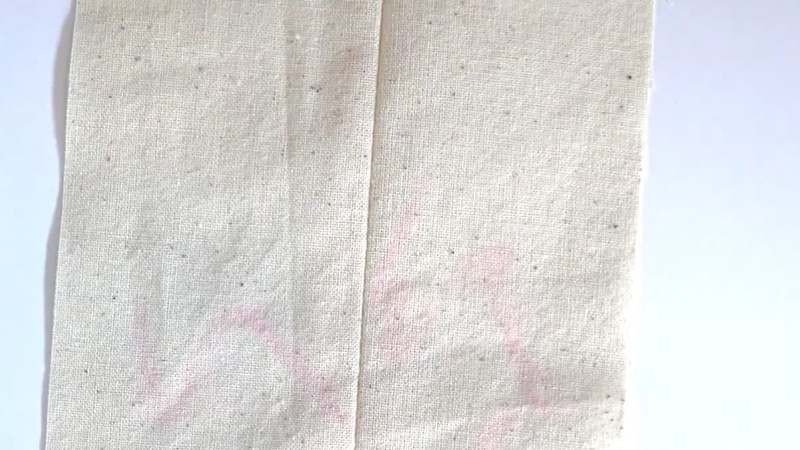
A superimposed seam is a simple and common type of seam where two fabric pieces are placed directly on top of each other with their right sides together and then stitched along the edge.
It’s one of the most basic seam types and is often used for its simplicity and functionality. Superimposed seams are suitable for a wide range of fabrics and sewing projects, from lightweight and delicate materials to heavier fabrics.
They provide a clean and secure way to join fabric pieces and serve as the foundation for more complex seam techniques. While not decorative, they are essential in many sewing applications for their strength and versatility.
12. Princess Seams
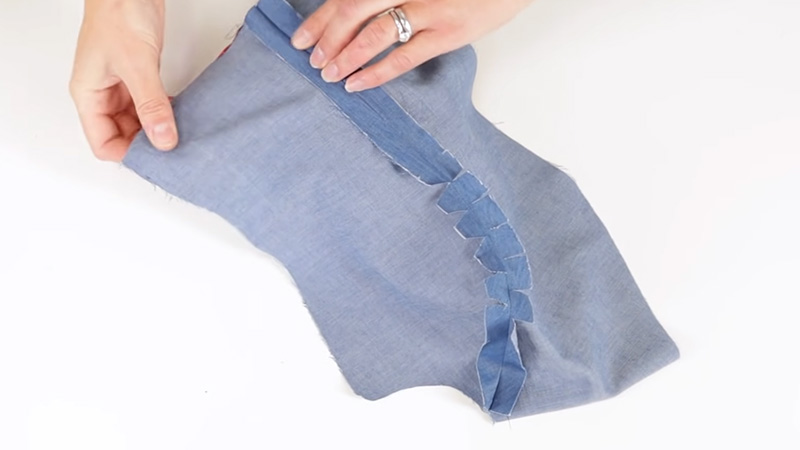
Princess seams are a type of seam used to create a tailored or contoured fit on women’s blouses and shirts. Rather than using darts to shape the fabric, princess seams run from the waist up to the shoulder seam or armscye in a curved, rounded style.
This style of seam creates a flattering shape that closely follows the female form. They can also be used to provide extra room in areas such as the bust or shoulders.
Princess seams are an ideal choice for blouses and shirts that need to have a more fitted look.
By using this type of seam, the fabric will fit more snugly and flatter the wearer’s figure. Additionally, princess seams can be used to create interesting design elements, such as gathers and pleats, on the garment.
13. Strap Seam
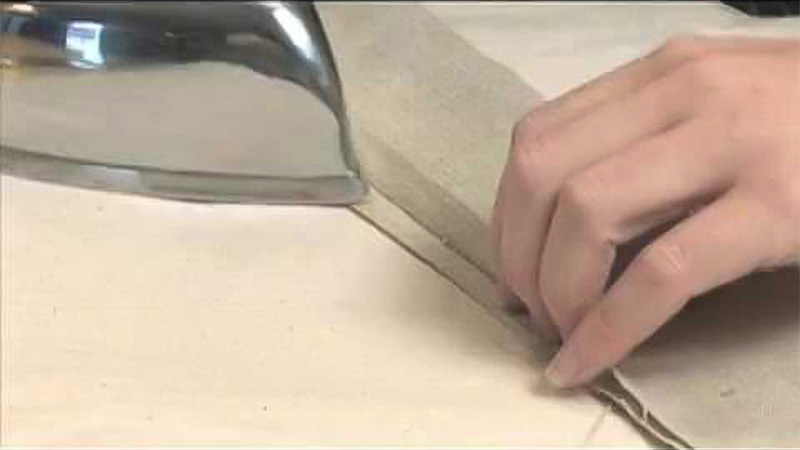
A strap seam is a specialized sewing technique used to create narrow, tubular fabric straps or bands. It involves folding a strip of fabric in half lengthwise with the wrong sides together and then stitching along the long edge, leaving the ends open.
Once sewn, the strap is turned right side out to reveal a clean, finished edge. Strap seams are often used for making spaghetti straps on dresses, handles for bags, or narrow ties for garments.
They provide a neat and durable way to create slender fabric strips that can be used for both functional and decorative purposes in sewing and fashion design.
14. Taped Seam
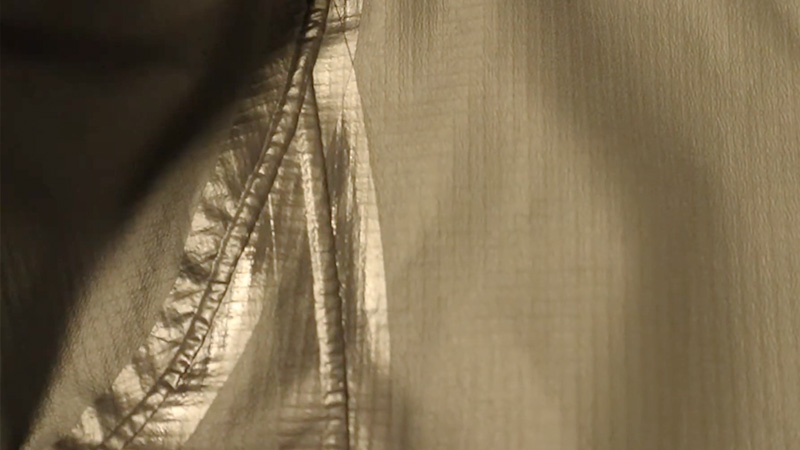
A taped seam is a waterproofing technique commonly used in outdoor gear and rainwear to prevent water from seeping through stitched seams. It involves applying a waterproof tape, often made of polyurethane or a similar material, over the stitched seam on the inside of the garment.
This tape forms a waterproof barrier that seals the small holes created by the stitching. Taped seams are essential for keeping the wearer dry in wet conditions, making them a vital component in rain jackets, tents, and other outdoor equipment.
The use of taped seams ensures that the garment remains waterproof, even under heavy rain or adverse weather conditions.
15. Corded or Piped Seam
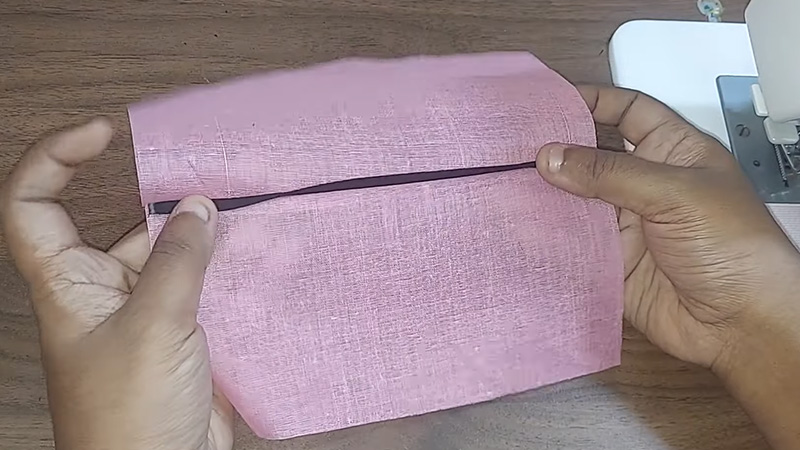
A corded or piped seam is a sewing technique that adds a decorative and structured element to garments and upholstery. It involves sewing a thin cord or piping into the seam allowance, typically sandwiched between two fabric pieces.
This creates a raised and visually appealing ridge along the seam line. Corded or piped seams are often used to add definition to garments, such as blazers or cushions, and they can be especially eye-catching when made with contrasting or complementary fabrics.
Beyond their decorative purpose, these seams can provide additional strength and structure to the item they adorn, making them a versatile and stylish sewing option.
16. Mock French Seam
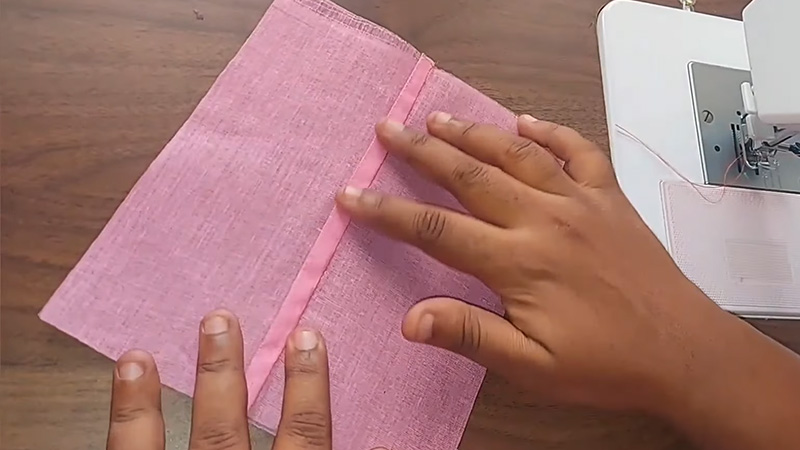
A mock French seam is a sewing technique that mimics the appearance of a traditional French seam but is less labor-intensive and bulky. In a mock French seam, fabric pieces are first sewn with their wrong sides together, just like a French seam.
However, instead of trimming and enclosing the raw edges with a second seam, the seam allowances are pressed to one side and topstitched. This creates a neat and finished look on the right side of the fabric, resembling a French seam without the added layers of fabric.
Mock French seams are often used for lightweight fabrics and are a quicker alternative for achieving a clean, polished seam finish.
17. Faced Seam
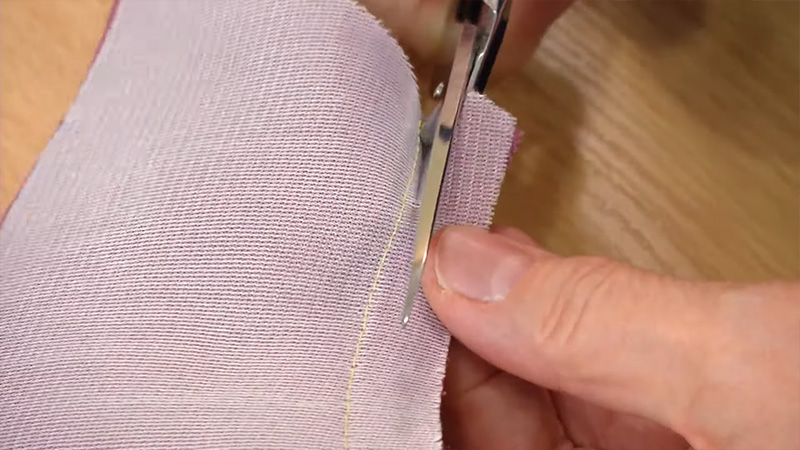
A faced seam is a sewing technique that involves attaching a separate piece of fabric to the edge of another fabric piece, providing a clean and finished look to the seam.
Typically, the facing fabric is cut to match the shape of the seam allowance, sewn right sides together with the main fabric, and then flipped to the wrong side, concealing the raw edges of the seam.
Faced seams are commonly used in tailored garments and items that require a neat and structured appearance, like necklines, armholes, and cuffs. They not only add reinforcement but also enhance the overall aesthetics of the finished product, ensuring a professional and polished result.
18. Piped Seam
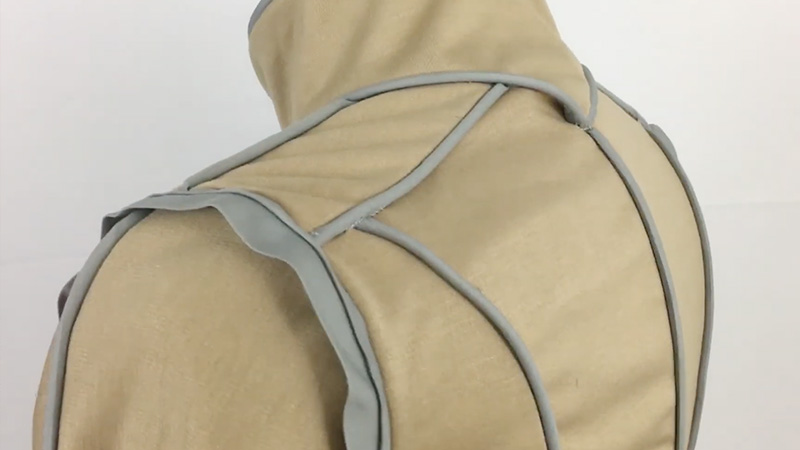
A piped seam is a decorative and structural sewing technique that involves inserting a cord or piping into a seam to create a raised and embellished effect.
This technique enhances the design of garments, home decor, and accessories by adding a distinct outline along the seam line. To create a piped seam, the cord or piping is sandwiched between the right sides of the fabric pieces, and then the seam is sewn, typically with a zipper foot to ensure precision.
Piped seams are popular for upholstery, cushions, and garments like blazers and dresses, where they contribute both style and structure to the finished product, creating a visually appealing and professional look.
19. Felled Seam
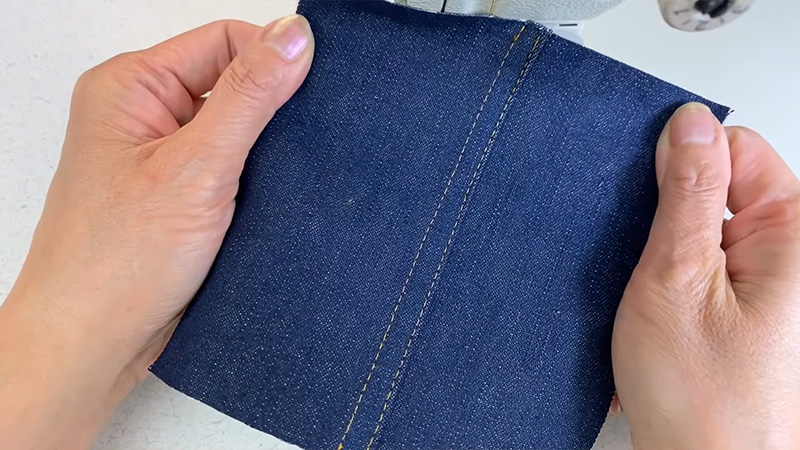
Felled seam is a type of seam used in sewing and tailoring. It involves placing one edge of fabric inside a folded edge of the same fabric, and then stitching the fold down.
This creates a secure and neat seam which encloses the raw edges of the fabric, protecting them from fraying. This type of seam is often used on the edges of garments, such as the inside of a shirt cuff, for a neat and professional finish.
The fold can be secured with either a topstitch or a whipstitch. A topstitch is a stitch which encases the entire fold, while a whipstitch only secures the two raw edges of the fabric together.
Both methods give a neat, secure seam which is durable and will stand up to wear and tear..
20. Zigzag Stitch
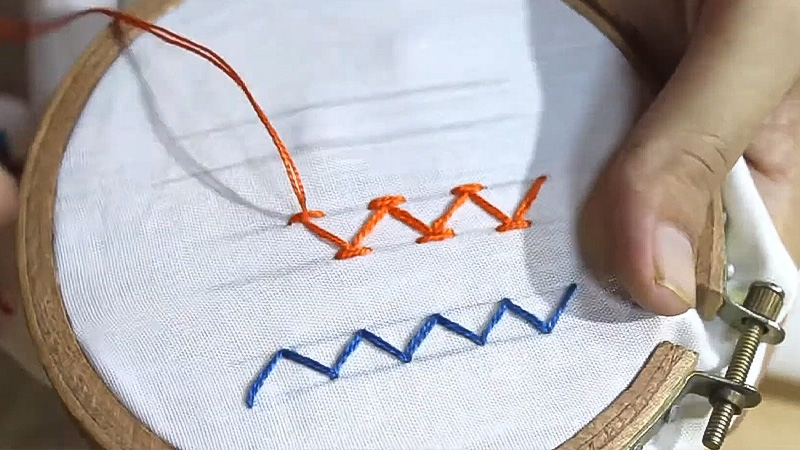
A zigzag stitch is a variation of the lockstitch, which is a basic stitching technique used for sewing. It is a special type of stitch that is used when a straight stitch will not be sufficient.
This includes applications where extra strength is needed, such as in reinforcing buttonholes or stitching stretchable fabrics.
It can also be used to temporarily join two pieces of fabric edge-to-edge.The zigzag stitch is typically created by alternating the direction of the thread in a single stitch.
This creates a back-and-forth pattern along the seam, which adds additional strength to the fabric.
The stitch is also beneficial for fabrics that are prone to stretching or fraying, as the alternating pattern helps to keep the edges of the fabric in place.The stitch is commonly used in many different types of sewing projects, from mending tears in clothing to adding decorative embellishments to garments.
It can be used to stitch intricate patterns, such as chevrons or diamonds, as well as to create hems and seams.
It is also a popular choice for quilting, as it allows for a more intricate design.Overall, the zigzag stitch is a versatile and useful technique that can be used in a variety of sewing applications.
It is an ideal choice for fabrics that require extra strength and stability, as well as for decorative purposes. With a little practice, it is a technique that anyone can master..
21. Hemmed Fell Seam
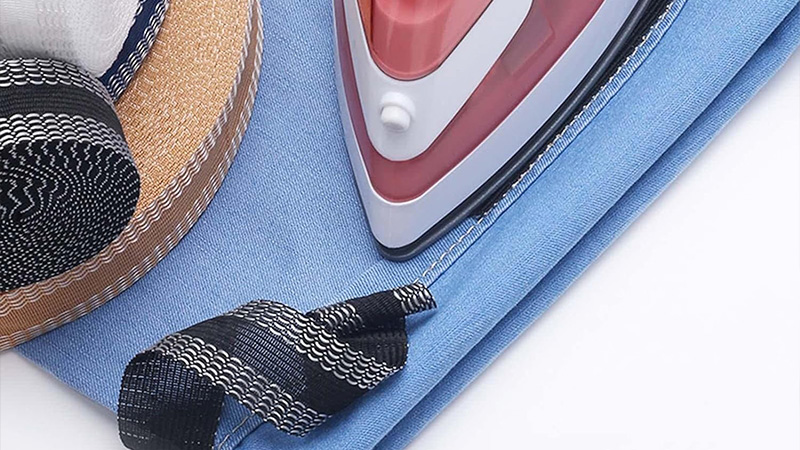
A hemmed fell seam is a strong and tidy sewing technique frequently used in heavy-duty applications, such as workwear and denim jeans. This method combines the durability of a flat-felled seam with the neat finish of a hem.
To create a hemmed fell seam, two fabric pieces are first joined with a plain seam, typically with a narrow seam allowance. One of the seam allowances is then folded over the other and stitched down, creating a clean edge that resembles a hem.
This seam provides extra strength and durability while also maintaining a polished appearance, making it an ideal choice for rugged, long-lasting garments that require both sturdiness and a refined finish.
22. Double Top Stitched Seam
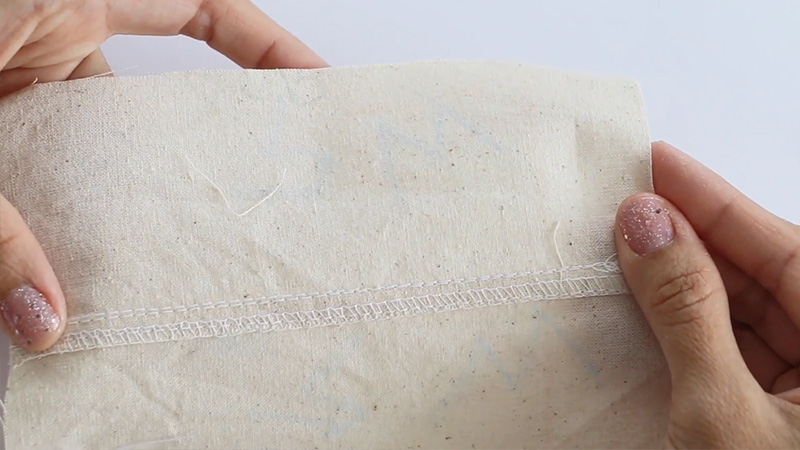
A double top-stitched seam is a robust and decorative sewing technique that involves stitching two parallel rows of stitches on the right side of the fabric, typically about 1/8 to 1/4 inch apart.
This technique not only reinforces the seam but also adds a stylish and professional look to the project. Double top-stitched seams are often used in denim jeans, bags, and other heavy-duty items, where both strength and aesthetics are essential.
The precision and symmetry of the double rows of stitching provide a polished finish, making this technique a popular choice for achieving a clean and durable seam with a touch of craftsmanship.
23. Sheet Seam/linen Seam
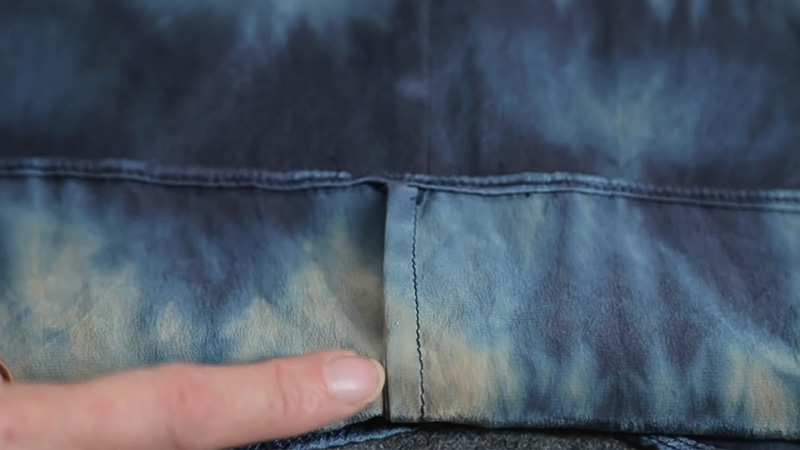
A sheet seam, often referred to as a linen seam, is a sewing technique primarily used for attaching two pieces of fabric together, especially in projects involving linens and bed sheets.
This method involves stitching the fabric pieces with a simple, straight seam, typically with a plain or French seam. Sheet seams are designed for practicality and durability, ensuring that bed linens and other fabric items remain securely joined through frequent use and laundering.
While they may lack the decorative flair of some other seam types, sheet seams are essential in ensuring the longevity and functionality of everyday items like sheets, pillowcases, and tablecloths.
Conclusion
seams are the unsung heroes of garment construction, playing a pivotal role in the functionality and aesthetics of our clothing. Whether it’s the reinforced durability of flat-felled seams in denim or the delicate elegance of French seams in fine fabrics, choosing the right seam type is an art in itself.
Seamstresses, tailors, and fashion designers must master this diverse array of techniques to create garments that not only withstand wear and tear but also showcase the beauty of precise craftsmanship.
With a deep understanding of seams, one can transform fabric into wearable art, ensuring that clothing is not just functional but a testament to creativity and skill.
Leave a Reply